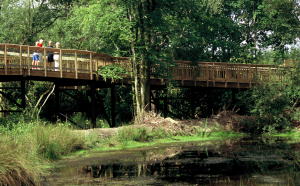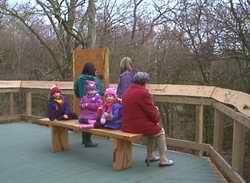
The walkway, unique to the south west, follows a 90 metre long route through the lower canopy of the woodland. The woods consist of a wide diversity of plant and animal life; the average oak tree supports hundreds of different species of invertebrate, saprophytic plants and many mammals including the elusive dormouse.
On your trip along the boardwalk you may be lucky enough to see marsh tit, nuthatch, sparrow hawk and great-spotted woodpecker. During the summer evenings a wide range of bat species including daubentons, noctule, and the rare greater horseshoe could be seen accompanied by the hoots of the tawny owl. Squirrels, foxes and roe deer are all residents and can be seen throughout the year.

The winners of a children’s poetry and art competition, held during the summer of 2003, have had their work routed into the sweet chestnut handrail. The handrail also incorporates fun games; visit the Park and see if you can lead the acorn to safety or match the bird to its missing beak!

The only restrictions are that young children and dogs are to be kept under close control and no riding of bicycles, thank you.
The structure of the aerial walkway was designed and constructed by Devon County Council; the interpretation was designed by Greenspace and supported by the Heritage Lottery Fund.